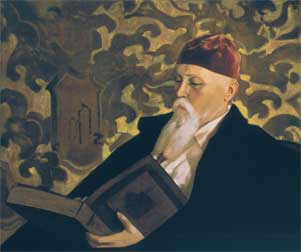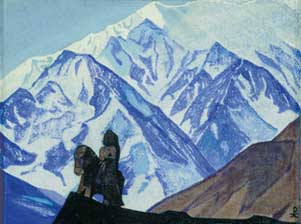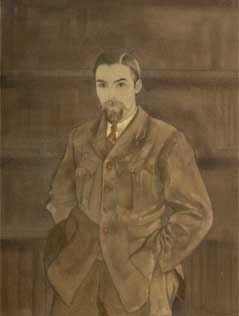| printer friendly | |||
|
|||
 | |
| S. Roerich. Portrait of N.К. Roerich. 1934 |
In the spring of 1945, the world was celebrating the Victory. Roerich approached it together with his Motherland. He stood at his Watch in the Himalayas, but was inseparable from what his Motherland was going through and what it was suffering. “If a man loves his motherland, the artist wrote, – he will implement in actions all his achievements in any place of the globe. Nobody and nothing will prevent him from expressing what is filling his heart in concrete deeds”20.
Nicholas Roerich not even once deviated from what was destined to him. The Watch which he kept was difficult and fameless. “But it is still cold on the watch tower, he wrote. – As if forgotten, forlorn, unnecessary! <…> Who knows, maybe they have left? Maybe, the atmosphere has completely changed? Have they forgotten about the lonely tower? I know, that they will not forget, that this tower is very important. But it is cold on the tower. The wind is piercing…”21 To stand on such a “tower”, great courage and great love were needed. The Russian painter had both.
In the Kullu hall, there is Roerich’s portrait painted by his younger son, Svetoslav Roerich. Nicholas Roerich was a wise Teacher for his sons. On the painting, he is plunged in reading, behind his back, there are whimsical signs resembling Oriental symbols. A big ancient book – like the “Book of Life” from his own painting. Only it is opened at the first page…
“Nicholas Roerich always believed, – his younger son would tell about him, – that the most important task of life was, in the long run, self-improvement. <…> He always worked first of all on himself. He wanted to rise above what he was and complete his life being a more perfect man. And he succeeded in it”22.
Nicholas Roerich’s Great Indian way was finishing. The way to his Motherland was starting.
“Himalayas, let me once again send you my sincere admiration. Same as whole beautiful India, let me once again send you my greetings for all the attracting and inspiring that fills your meadows and groves, and ancient cities, and sacred rivers, and great people”23.
Nicholas Roerich submitted a petition for a visa and started getting ready for a long journey. Everything was prepared, the paintings were packed. But the visa was delaying. There was no answer…
 | |
| N. Roerich. Guga Chohan. 1933 |
Once, his Motherland saw Roerich off with Nikolai Asseyev words:
|
The one who headed for a nameless shore
The saddled horse was led behind the fallen prince.
|
The poem turned out to be prophetic. On the mountain slope, a little lower than the villa, a grey granite stone is standing. The inscription on the stone says: “The body of Maharishi Nicholas Roerich, a great friend of India, was committed to fire at this place on Maghar 30, 2004, of Vikram Era, corresponding to December 15, 1947. Om Ram”.
After Nicholas Roerich’s death, Helena Roerich with her son Yuri left the valley of Kullu and went to the Eastern Himalayas, to a small city of Kalimpong.
 | |
| Jewelry from H. Roerich’s collection |
Living in the Himalayas, separated from her Motherland with an immense distance, she never broke links with it either spiritually, or in her heart. She understood well what was done in Russia. “Consciousness of exhausted with suffering people who have lost faith in justice and protection of their Heavenly Father cannot be brought back into the former paralyzing fetters. If a spiritual upsurge is possible, it will be different in its essence and quality <…>, – Helena Roerich wrote, – and to get established, it will need theses substantiated by ration and logic. One cannot close one’s eyes at the fact that a great shift has taken place in the mentality of masses. For suffering is a great teacher and transmutator. It is not colorless and smooth life that enlightens us”24.
 | |
| S. Roerich. Self-portrait. 1940s |
The elder son realized his father’s dream. In 1957, George Roerich returned to his Motherland. An extensively educated person, a major scientist, Orientalist, and philologist, he worked at the Institute of Oriental Studies of the USSR Academy of Science until his death in 1960.
In the hall of Kullu, there is the “Portrait of My Brother”, painted by Svetoslav Roerich. The portrait is not finished, but an image of a great charm shows on it. Determination, will, concentration – and amazingly friendly, radiant eyes.
 | |
| S. Roerich. Portrait of G. Roerich
(Uncompleted). 1930s. |
The younger son Svetoslav Roerich, married after the war a wonderful Indian actress Devika Rani and lived in India, in Bangalore, until his departure from life in 1993.
We see Svetoslav Roerich’s self-portrait in front of us. Spiritual face, beautiful regular features, attentive gentle eyes. He also painted. And there were also mountains on his paintings. But the son’s eye turned more and more often to people who lived in the mountains. “Dancer from Kullu”, “Portrait of a woman at the background of colorful rocks” – Beauty dwells on these canvases. Spiritual, subtle beauty of the people of ancient India.
Svetoslav Roerich, executing his parents’ will, in 1990, passed over the Roerichs family heritage to their Motherland. He became the creator of our Museum.
“Let us apply to the future with complete confidence <…>, N. Roerich wrote. – Let us call it with all the power of spirit. Let us feel that it – the wonderful future – is possible. Possible in incontestable reality, in striving for the high quality of everyday labor, for joyous creative work and creation of the good. And not little is the power of man applied for the common benefit, for the common ascend. Each sunrise is calling forward, forward, forward!”26
|
|
||
|
||
